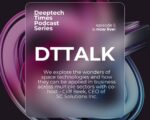
By Daniel Hand
Twelve months ago, “Generative Design AI” appeared on the fringes of the Gartner hype cycle for emerging technologies. Today, Gartner believes Generative AI (GenAI) is close to the peak of inflated expectations.
The benefits of GenAI are compelling and far reaching. Analysts believe it will impact every major industry and work function.
A 2023 McKinsey report states that current GenAI and other technologies have the potential to automate work activities that absorb 60 to 70 per cent of employees’ time today. IDC research also highlighted how two-thirds of organisations in Asia Pacific are exploring or investing in GenAI this year.
As 2024 approaches, I expect companies to intensify efforts on operationalising and improving GenAI, and adjust their approaches to managing growing volumes of data across environments, especially the cloud, to drive flexibility and growth.
Here are some trends we will see next year.
#1 – Strong MLOPS and data integration will help operationalise GenAI
Since ChatGPT v3.5 was released in November 2022, organisations have faced the challenge of reaping its benefits while safely providing sufficient contextual data for it to be useful.
ChatGPT and other software-as-a-service (SaaS) based large language models (LLMs) have presented significant data privacy challenges for organisations. In many cases, the questions, answers and contextual data may be sensitive. This is unsuitable for public multi-tenanted services that reuse this data to retrain models.
Rapid advances in open source LLMs like Meta’s Llama-v2 have delivered comparable performance to ChatGPT and present a viable alternative. However, GenAI models are difficult to move from the lab into production in a scalable and reliable way. They are also typically shared between multiple applications, and therefore pose greater data integration challenges compared with traditional machine learning (ML) models.
In 2024, I expect organisations to continue to focus on developing strong machine learning operations (MLOPS) and data integration capabilities.
#2 – Organisations will double down on RAG and fine-tuning to optimise LLMs
There are several approaches to optimising the performance of LLMs, including prompt engineering, retrieval augmented generation (RAG), and fine-tuning.
RAG uses content from a knowledge base to enrich the prompt and provide necessary context. A key component of the RAG architecture is a database of knowledge base content that is indexed in a special way.
User questions are encoded in a mathematical representation that can then be used to search for the content that’s nearest to it in the database. The user’s question, as part of the prompt, is then sent to the LLM for inference. Providing both the question and domain context delivers significantly better results.
RAG has proven to be an effective approach to adopting LLMs because it does not require any training or tuning of LLMs, while still delivering good results. It does, however, require data engineering pipelines to maintain the knowledge base repository, and a specialised vector database to store the indexed data.
I believe that RAG will continue to be an accessible approach to GenAI for many organisations in 2024.
One approach to fine tuning that has gained a lot of interest in 2023 is performance efficient fine tuning (PEFT). PEFT trains a small neural network on domain specific data and sits alongside the general purpose LLM. This provides most of the performance benefits of retraining the larger LLM, but at a fraction of the cost and required training data. Fine-tuning LLMs requires stronger ML capabilities, but can lead to greater efficiency, explainability and more accurate results, especially when training data is limited.
In 2024, I foresee that fine-tuning approaches, like PEFT, will be increasingly used by organisations, both for net-new projects and replacing some of the earlier RAG architectures. I expect the uptake to be greatest within organisations with larger and more capable data science teams.
#3 – Organisations will shift from cloud first to cloud considered
Cloud computing will continue to be an important, transformative technology in organisational data strategy in 2024.
In 2023, some businesses adjusted their cloud strategy. They shifted from a cloud first approach to a considered and balanced stance aligned with the conservative moves made by most large organizations. This was driven by several factors, including the economics of the cloud for many predictable analytical workloads, data management regulations, and organisational fiscal policy, considering changing economic conditions.
These organisations have settled on a cloud native architecture across both public and private clouds to support their data and cloud strategy; the additional architectural complexity associated with cloud native being offset with the flexibility, scalability and cost savings it provides.
The resulting data fabric across public and private clouds provides the foundation for an intelligent, automated, and policy driven approach to data management.
#4 – Data management automation, data democratisation, zero-trust security will remain top of mind
Data continues to be generated and acquired at an exponential rate, driving the need to adopt greater levels of automation and intelligence in data platform management. Observability across infrastructure, platforms and workloads will therefore play an increasingly important role in 2024.
This is a precursor to automating intelligent platforms that are highly performant, reliable and efficient. At the core of the intelligent data platform will be operational data used to train ML models. Data practitioners will continue to push for greater democratisation of data and greater self-service options. This is aligned with one of the most important principles of the data mesh paradigm.
The most innovative organisations empower data scientists, data engineers and business analysts to get greater insight from data without going through data gatekeepers. Removing friction from all stages of the data lifecycle and increasingly providing access to real-time data will be a focus of organisations and technology providers in 2024.
Hybrid cloud native architectures, adoption of third-party SaaS and platform-as-a-service (PaaS) services and a strengthening of cybersecurity continues to drive a focus on data security, zero-trust and clear separation of responsibilities for data management.
Zero-trust requires the continuous authentication and authorisation of users and systems working with data. These entities will increasingly be granted the minimum permissions required to perform a given task with strong auditability. This will be a forcing function to drive innovation within data governance and management, while meeting the increasing demands to democratise access to data.
In 2024, I expect technology to increasingly simplify the implementation and enforcement of zero-trust both within organisations and more so across them, as data federation becomes an increased area of interest.
#5 – An impending migration to open data lakehouses
2022 witnessed significant innovation within data lakehouse implementations, with leading industry data management providers settling on Apache Iceberg as the de facto format. Iceberg’s rapid adoption as the preferred open technology almost certainly influenced several data management providers to change their open source strategy and build support for it into their products.
In 2024, I expect to see a steady migration of data and workloads into open data lakehouse architectures across public and private clouds.
Daniel Hand is field CTO for APJ at Cloudera












